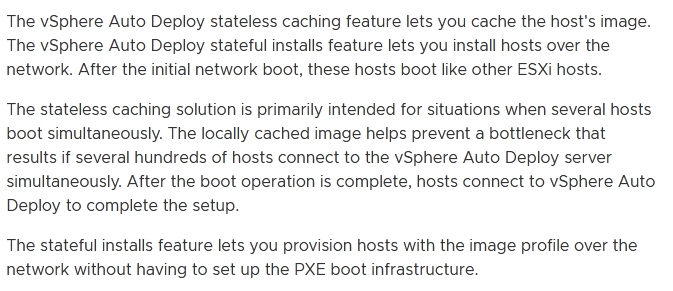Which two of the listed requirements would be classified as performance non-functional requirements? (Choose two.)
AD
Reference:
https://technicloud.com/category/vmware/
An architect will be taking over control of a former Linux server fleet and repurposing the hardware into a new vSphere cluster. The current environment is already connected to the network but the hosts do not have any local disks. Since the fleet hardware is uniform, the architect can use a single ESXi image. All hosts within the cluster have the same CPU and memory capacity.
Which ESXi deployment method should the architect use?
A
Reference:
https://docs.vmware.com/en/VMware-vSphere/7.0/com.vmware.esxi.install.doc/GUID-0813B4BE-485D-4129-902B-49AA42EBF54E.html
An architect is finalizing the design for a new vCenter Server High Availability deployment.
What is one thing the architect must document in the design?
A
An architect is considering placement of virtual machines within an existing VMware software-defined data center (SDDC).
During the discovery phase, the following information is documented:
Cluster One -
✑ Six ESXi hosts
✑ vSphere HA with host failures cluster tolerates = 1
✑ Proactive HA is enabled and set to automated
✑ Fully Automated vSphere DRS
✑ Transparent Page Sharing (TPS) is enabled
Cluster Two -
✑ Eight ESXi hosts
✑ vSphere HA with host failures cluster tolerates = 1
✑ Proactive HA is disabled
✑ Partially Automated vSphere DRS
✑ Transparent Page Sharing (TPS) is disabled
Cluster Three -
✑ Three ESXi hosts
✑ vSphere HA with admission control is disabled
✑ Proactive HA is not supported
✑ Transparent Page Sharing (TPS) is disabled
Virtual Machine Resource Profile 1
✑ Memory sharing techniques should not be used
✑ Virtual machines should be automatically restarted in the event of host failure if resources are available
✑ Automated initial virtual machine placement
Virtual Machine Resource Profile 2
✑ Memory sharing techniques should not be used
✑ Virtual machines should be automatically restarted in the event of host failure regardless of available resources
✑ Automated initial virtual machine placement
Which two recommendations should the architect make for placement of the virtual machines to meet resource profile requirements? (Choose two.)
BE
An architect is tasked with designing a greenfield VMware software-defined data center (SDDC) solution that will be used to deliver a private cloud service for a customer.
During the initial meeting with the service owner and business sponsor, the customer has provided the following information to help inform the design:
✑ The solution must support the concurrent running of 1,000 virtual machines
✑ The production environment must be delivered across two geographically dispersed data centers
✑ All virtual machines must be capable of running in either data center.
✑ The two data centers are currently connected to each other through a single but diversely routed, high bandwidth and low latency link.
✑ The link between the two data centers is capable of supporting a round-trip time (RTT) of 150 ms
✑ The existing server hardware standard document states that all virtual infrastructure hosts must be deployed using vSAN ReadyNodes
✑ The service owner has stated that it is critical to ensure the availability target of 99.9%
✑ All virtual machine backups must be completed using the existing backup service
✑ The recovery time objective (RTO) for the service is five minutes
✑ The recovery point objective (RPO) of the service is four hours
Which two elements represent risks to the successful delivery of this solution? (Choose two.)
DE
An architect is designing a new vSphere platform for a customer to meet the following requirements:
✑ The platform must be deployed into five physically separate sites.
✑ The sites are spread across multiple regions.
✑ Some sites require more than one vCenter Server.
✑ The platform must provide an administrator with the ability to access virtual infrastructure components across all sites from a single management tool instance.
Which single sign-on (SSO) design recommendation will meet these requirements?
C
The storage team at an organization is planning to migrate from an older Fibre Channel storage environment to a new environment using IP-based storage.
Which two switch features or characteristics are appropriate for IP storage networks? (Choose two.)
BC
An architect is designing a new VMware software-defined data center (SDDC) that will consist of 100 branch sites connected to a single VMware vCenter Server within the primary data center. To allow for the use of existing automation scripts, there is a requirement to replicate the names of the virtual distributed port groups across all sites. The procurement team purchases licensing and there is no further budget allocated.
Which design decision should the architect make to meet this requirement?
B
An architect is designing a new greenfield environment that will install ESXi on local disks. There is a requirement to streamline initial and future installations of
ESXi hosts.
Which configuration option should the architect recommend for installing ESXi hosts to meet these requirements?
B
Following a recent acquisition, an architect needs to merge IT assets into its current data center. The combined vSphere environment will need to run the newly acquired company's virtual machines.
Network integration work has already been completed and the current environment has capacity to host all virtual machines. The Operations team needs to identify which virtual machines belong to the acquired company and report on their usage.
How should the architect merge the company's assets and virtual machines?
D